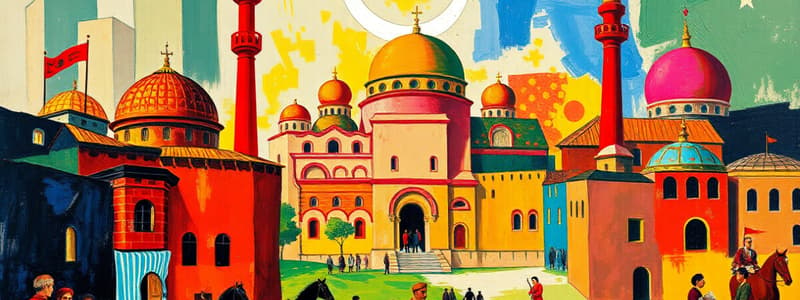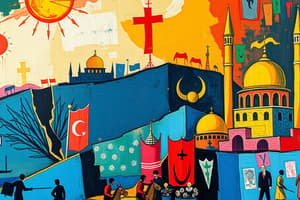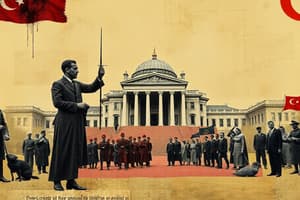Podcast
Questions and Answers
Which political group seized power in an armed coup in 1913 and established a dictatorial regime until the end of WWI?
Which political group seized power in an armed coup in 1913 and established a dictatorial regime until the end of WWI?
- Community of Union and Progress (correct)
- Ahrar Firka
- Party of Freedom and Understanding
- Saviour Officers
Which country was the Ottoman Empire allied with during the First World War?
Which country was the Ottoman Empire allied with during the First World War?
- Germany (correct)
- USA
- Britain
- France
Which treaty formally ended the First World War for the Ottoman Empire?
Which treaty formally ended the First World War for the Ottoman Empire?
- Armistice of Mudanya
- Treaty of Sevres (correct)
- Treaty of Lausanne
- Armistice of Mudros
During the Second Balkan War, which group was expelled by the Ottomans as they regained Edime?
During the Second Balkan War, which group was expelled by the Ottomans as they regained Edime?
What significant action did the Ottoman government take regarding Armenians in Anatolia in 1915?
What significant action did the Ottoman government take regarding Armenians in Anatolia in 1915?
Which of the following reforms was NOT associated with the Community of Union and Progress’s secularization efforts?
Which of the following reforms was NOT associated with the Community of Union and Progress’s secularization efforts?
Which of the following was NOT a front where the Ottomans fought during the First World War?
Which of the following was NOT a front where the Ottomans fought during the First World War?
Who was the first Ottoman ruler to bear the title of Sultan and strike the first Ottoman coins?
Who was the first Ottoman ruler to bear the title of Sultan and strike the first Ottoman coins?
Which group did NOT belong to the Ruling Military (askeri) class within the Ottoman structure?
Which group did NOT belong to the Ruling Military (askeri) class within the Ottoman structure?
Which territories did Selim I annex to radically change the status of the sultan?
Which territories did Selim I annex to radically change the status of the sultan?
Which of the following titles was assumed by Sultan Orhan's son, indicating his claim to the title of Empire?
Which of the following titles was assumed by Sultan Orhan's son, indicating his claim to the title of Empire?
According to Sunni doctrine, which statement is true regarding the caliphate's legitimacy?
According to Sunni doctrine, which statement is true regarding the caliphate's legitimacy?
Which statement about the Ottoman accession to the throne is NOT true?
Which statement about the Ottoman accession to the throne is NOT true?
Which Ottoman ruler is known for his military campaigns that established the empire's territories?
Which Ottoman ruler is known for his military campaigns that established the empire's territories?
What was a key factor in the change of the Ottoman sultan's status during Selim I's reign?
What was a key factor in the change of the Ottoman sultan's status during Selim I's reign?
Which of the following was NOT a component of the Reaya class in the Ottoman Society?
Which of the following was NOT a component of the Reaya class in the Ottoman Society?
The Ottoman Empire was named after which figure?
The Ottoman Empire was named after which figure?
What does the term 'Devshirme' refer to in the context of the Ottoman Empire?
What does the term 'Devshirme' refer to in the context of the Ottoman Empire?
Which religious order were the Janissaries most closely associated with?
Which religious order were the Janissaries most closely associated with?
The Ottoman law system incorporated Shariat and which other type of law?
The Ottoman law system incorporated Shariat and which other type of law?
Which official assisted the Kadi in municipal service executions?
Which official assisted the Kadi in municipal service executions?
When were the Janissary corps formally organized?
When were the Janissary corps formally organized?
Who performed the execution of a judge in the Ottoman legal system?
Who performed the execution of a judge in the Ottoman legal system?
Which of the following groups was NOT a member of the ilmiye class?
Which of the following groups was NOT a member of the ilmiye class?
Which of the following individuals was NOT a notable figure during the Ottoman Empire?
Which of the following individuals was NOT a notable figure during the Ottoman Empire?
Which structure was established as part of Sultan Mahmut II's administrative reforms?
Which structure was established as part of Sultan Mahmut II's administrative reforms?
Which advisory body was formed to manage the legislative burden during Sultan Mahmut II's rule?
Which advisory body was formed to manage the legislative burden during Sultan Mahmut II's rule?
Which of the following regions posed a major threat to the Ottoman Empire in the 17th and 18th centuries?
Which of the following regions posed a major threat to the Ottoman Empire in the 17th and 18th centuries?
Which of the following was NOT one of Sultan Mahmut II's reforms?
Which of the following was NOT one of Sultan Mahmut II's reforms?
Which reform was promised in the Edict of Tanzimat?
Which reform was promised in the Edict of Tanzimat?
What was the historical significance of the period from 1839 to 1876 in Ottoman history?
What was the historical significance of the period from 1839 to 1876 in Ottoman history?
Which of the following reforms aimed to eliminate legal inequalities in the Ottoman Empire?
Which of the following reforms aimed to eliminate legal inequalities in the Ottoman Empire?
What was one of the first major reforms initiated by Sultan Mahmut II?
What was one of the first major reforms initiated by Sultan Mahmut II?
Which of the following reforms aimed at improving the taxation system in the Ottoman Empire?
Which of the following reforms aimed at improving the taxation system in the Ottoman Empire?
What was a consequence of the policy that caused unrest and rebellions led by the janissaries?
What was a consequence of the policy that caused unrest and rebellions led by the janissaries?
Which Peace Treaty resulted in the Ottomans withdrawing from Hungary, Croatia, and Slovenia in 1699?
Which Peace Treaty resulted in the Ottomans withdrawing from Hungary, Croatia, and Slovenia in 1699?
Which reform was not implemented during the 18th century military reforms?
Which reform was not implemented during the 18th century military reforms?
Who is credited with introducing the Printing Press to the Ottoman Empire in the 18th century?
Who is credited with introducing the Printing Press to the Ottoman Empire in the 18th century?
In the 18th century, which term refers to the regional leaders who effectively governed areas in the Balkans and Anatolia?
In the 18th century, which term refers to the regional leaders who effectively governed areas in the Balkans and Anatolia?
Which Sultan established the permanent Ottoman embassies in important European cities?
Which Sultan established the permanent Ottoman embassies in important European cities?
What does Vaka-i Hayriye refer to in Ottoman history?
What does Vaka-i Hayriye refer to in Ottoman history?
Which of the following was not a reform in Mahmud II's educational reforms?
Which of the following was not a reform in Mahmud II's educational reforms?
What was one significant outcome of the military reforms in the Ottoman Empire during the 18th century?
What was one significant outcome of the military reforms in the Ottoman Empire during the 18th century?
Which upheaval contributed to the calls for reform within the Ottoman military forces?
Which upheaval contributed to the calls for reform within the Ottoman military forces?
Flashcards
Who was the first Ottoman Sultan?
Who was the first Ottoman Sultan?
The Ottoman ruler who first used the title "Sultan" and minted Ottoman coins, signifying their independence.
Which group was NOT part of the Ottoman ruling military class?
Which group was NOT part of the Ottoman ruling military class?
The ruling military class in the Ottoman Empire included military personnel, palace officials, and administrative cadres. Merchants were not part of this class.
How did Selim I's conquests change his status?
How did Selim I's conquests change his status?
By conquering Syria, Egypt, and Arabia, Selim I took over the core lands of the Caliphate, transforming his role from a frontier ghazi sultan to a more powerful figure.
Who used the title "Hudavendigar" to claim imperial power?
Who used the title "Hudavendigar" to claim imperial power?
Signup and view all the flashcards
What were the Ottoman's claims to the Caliphate?
What were the Ottoman's claims to the Caliphate?
Signup and view all the flashcards
How did the Ottoman succession system work?
How did the Ottoman succession system work?
Signup and view all the flashcards
Reaya
Reaya
Signup and view all the flashcards
Nahiya
Nahiya
Signup and view all the flashcards
Janissaries
Janissaries
Signup and view all the flashcards
Devshirme
Devshirme
Signup and view all the flashcards
Ottoman Law
Ottoman Law
Signup and view all the flashcards
Osman I
Osman I
Signup and view all the flashcards
A type of Islamic financing where the seller buys an asset and then immediately sells it to the buyer at a markup, commonly used for trade and commerce in the Ottoman Empire.
A type of Islamic financing where the seller buys an asset and then immediately sells it to the buyer at a markup, commonly used for trade and commerce in the Ottoman Empire.
Signup and view all the flashcards
Muhtesib
Muhtesib
Signup and view all the flashcards
Bektashi
Bektashi
Signup and view all the flashcards
Kanun
Kanun
Signup and view all the flashcards
Janissary Corps decline
Janissary Corps decline
Signup and view all the flashcards
Peace Treaty of Karlowitz
Peace Treaty of Karlowitz
Signup and view all the flashcards
Abolishment of Janissary Corps
Abolishment of Janissary Corps
Signup and view all the flashcards
Who introduced the printing press?
Who introduced the printing press?
Signup and view all the flashcards
Rise of the Ayan
Rise of the Ayan
Signup and view all the flashcards
Ottoman Embassies
Ottoman Embassies
Signup and view all the flashcards
Vaka-i Hayriye
Vaka-i Hayriye
Signup and view all the flashcards
Mahmud II's Educational Reforms
Mahmud II's Educational Reforms
Signup and view all the flashcards
Who gained power after the 'Bab-ı Ali Coup' of 1913?
Who gained power after the 'Bab-ı Ali Coup' of 1913?
Signup and view all the flashcards
Who were the Ottoman Empire's allies in World War I?
Who were the Ottoman Empire's allies in World War I?
Signup and view all the flashcards
What ended the Ottoman Empire's involvement in World War I?
What ended the Ottoman Empire's involvement in World War I?
Signup and view all the flashcards
Who did the Ottomans reclaim Edirne from in the Second Balkan War?
Who did the Ottomans reclaim Edirne from in the Second Balkan War?
Signup and view all the flashcards
What happened to the Armenians of Anatolia in 1915?
What happened to the Armenians of Anatolia in 1915?
Signup and view all the flashcards
What were some of the secular reforms enacted by the Committee of Union and Progress (CUP)?
What were some of the secular reforms enacted by the Committee of Union and Progress (CUP)?
Signup and view all the flashcards
Which front did the Ottomans NOT fight on during World War I?
Which front did the Ottomans NOT fight on during World War I?
Signup and view all the flashcards
Cabinet System in Ottoman Empire
Cabinet System in Ottoman Empire
Signup and view all the flashcards
Meclis-i Vala-i Ahkam-i Adliye
Meclis-i Vala-i Ahkam-i Adliye
Signup and view all the flashcards
Tanzimat Era
Tanzimat Era
Signup and view all the flashcards
Threats to the Ottoman Empire (17th-18th centuries)
Threats to the Ottoman Empire (17th-18th centuries)
Signup and view all the flashcards
Tanzimat Reforms
Tanzimat Reforms
Signup and view all the flashcards
Takvim-i Vekayi (Calendar of Events)
Takvim-i Vekayi (Calendar of Events)
Signup and view all the flashcards
Legal Equality for Muslims and Non-Muslims
Legal Equality for Muslims and Non-Muslims
Signup and view all the flashcards
Just Taxation System (Tanzimat)
Just Taxation System (Tanzimat)
Signup and view all the flashcards
Abolition of Tax-Farming
Abolition of Tax-Farming
Signup and view all the flashcards
Study Notes
Section I: The Ottomans: From a Principality to Empire
-
In the 16th and 17th centuries, the Ottoman Empire faced the Iranian Sasanid state as their most powerful rival on the eastern front.
-
The Battle of Ankara (1402) resulted in the Ottomans entering a period of interregnum.
-
Before the Ottomans conquered Constantinople in 1453, it was the political center of the Byzantine Empire.
-
Ottoman Sultan Murad I, who ruled from 1362 to 1389, conquered Edirne (Adrianople) in 1369 and established it as his new capital.
-
The destruction of the Anatolian Seljuk State by the Mongols in 1243 led to the emergence of the Turcoman Principalities in Anatolia.
-
The first Ottoman capital city was Bursa, captured by Orhan Bey in 1326.
-
The Battle of Ankara (1402) saw the defeat of Ottoman Sultan Bayezid I by the forces of Timur (Tamerlane)
-
In 1571, Sultan Selim II conquered Cyprus from the Lusignans.
-
The Ottomans defeated the Lusignans in 1571 during the capture of Cyprus.
Section II: Ottoman Statecraft, Society, and Institutions in the Classical Age
-
The official written language of the Ottomans was Arabic.
-
Mehmed II, after conquering Constantinople, established himself as a prominent Islamic leader, elevating the importance of Holy War.
-
The Ottomans considered Mehmed II the greatest Islamic sovereign after the first four caliphs.
-
With the conquest of Constantinople, Mehmed II claimed the legacy of the Roman Empire.
-
The Ottoman ruler who first used the title of Sultan was Murad I.
-
The Ruling Class (Askeri) in the Ottoman Empire was divided into military personnel (Seyfiyye), palace officials (Mülkiye), religious scholars (Ilmiye), and administrators (Kalemiye)
-
The Sultans of the Ottoman Empire had the right to control the treasury and archives; their appointment was in the hands of God
-
The Sultans' legitimacy was determined by their success in acquiring and holding the seat of power and controlling the state's resources.
Section III: Ottoman Decline, Reform, and Disintegration
-
Factors contributing to the corruption of the Janissary Corps included family connections, vested interests, and a shift in recruitment practices.
-
The Treaty of Karlowitz (1699) marked the end of Ottoman domination over Eastern Europe.
-
The establishment of a printing press in the 18th century marked a significant step within the Ottoman Empire
-
Various reforms, such as the establishment of the New Engineering School (Mühendishane-i Cedide), were implemented in the 18th century.
-
Notable figures like the notable figures like Köçi Bey, were among those connected to such developments during this period
-
The Ottomans experienced a decline in their centralized state structure as notables gained considerable authority in Balkans and Anatolia
-
Mahmud II launched various reforms, including those concerning the military and education systems, which aimed to modernizing the empire
-
One important event was the Vaka-i Hayriye (Beneficent Event) in 1826, which marked the abolition of Janissaries.
Additional Sections: (Questions 21-90)
- Specific details are provided for various events, individuals, and institutions within the Ottoman Empire, spanning different time periods.
Studying That Suits You
Use AI to generate personalized quizzes and flashcards to suit your learning preferences.
Related Documents
Description
Test your knowledge on the history of the Ottoman Empire, focusing on its transformation from a principality to a dominant empire. This quiz covers key events such as the conquest of Constantinople, major battles, and significant rulers. Dive into the intricate past of one of history's most influential empires.




